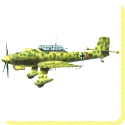 Junkers Ju 87 — The Junkers (German aircraft manufacturer) Ju 87 or Stuka (from Sturzkampfflugzeug, “dive bomber”) was a two-man (pilot and rear gunner) German ground attack aircraft. Designed by Hermann Pohlmann, the Stuka first flew in 1935 and made its combat debut in 1936 as part of the Luftwaffe’s Condor Legion during the Spanish Civil War.
Junkers Ju 87 — The Junkers (German aircraft manufacturer) Ju 87 or Stuka (from Sturzkampfflugzeug, “dive bomber”) was a two-man (pilot and rear gunner) German ground attack aircraft. Designed by Hermann Pohlmann, the Stuka first flew in 1935 and made its combat debut in 1936 as part of the Luftwaffe’s Condor Legion during the Spanish Civil War.
The aircraft was easily recognizable by its inverted gull wings, fixed spatted undercarriage and its infamous Jericho-Trompete (“Jericho Trumpet”) wailing siren, becoming the propaganda symbol of German air power and the blitzkrieg victories of 1939–1942. The Stuka’s design included several innovative features, including automatic pull-up dive brakes under both wings to ensure that the aircraft recovered from its attack dive even if the pilot blacked out from the high acceleration.
Although sturdy, accurate, and very effective, the Ju 87 was vulnerable to modern fighter aircraft, like many other dive bombers of the war. Its flaws became apparent during the Battle of Britain; poor manoeuvrability and a lack of both speed and defensive armament meant that the Stuka required heavy fighter escort to operate effectively.
The Stuka operated with further success after the Battle of Britain, and its potency as a precision ground-attack aircraft became valuable to German forces in the Balkans Campaign, the African and Mediterranean Theaters and the early stages of the Eastern Front campaigns where Allied fighter resistance was disorganised and in short supply.
Once the Luftwaffe had lost air superiority on all fronts, the Ju 87 once again became an easy target for enemy fighter aircraft. In spite of this, because there was no better replacement, the type continued to be produced until 1944. By the end of the conflict, the Stuka had been largely replaced by ground-attack versions of the Focke-Wulf Fw 190, but was still in use until the last days of the war. An estimated 6,500 Ju 87s of all versions were built between 1936 and August 1944.
Oberst Hans-Ulrich Rudel was the most notable Stuka ace and was the most highly decorated German serviceman of the Second World War. On 29 December 1944, he became the only serviceman to receive the highest German military award, the Knight’s Cross with golden Oak Leaves, Swords and Diamonds.
General Description
The Stuka’s design included some innovative features, including automatic pull-up dive brakes under both wings to ensure that the plane recovered from its attack dive even if the pilot blacked out from the high acceleration, and a wind-powered siren under its nose (later mounted to the front upper section of each fixed landing gear strut) that wailed during dives to frighten its victims. These were named Jericho-Trompeten, or “Trumpets of Jericho”, by Junkers and were a form of psychological warfare. Its rugged fixed undercarriage allowed it to land and take-off from improvised airstrips close to the battlefront, giving close support to the advancing German forces. 5,752 Ju 87 of all versions were built between 1936 and August 1944.
It was a Ju 87 that achieved the first air victory during World War II, on September 1, 1939 (the opening day of hostilities), when Kettenführer Leutnant Frank Neubert shot down a Polish PZL P.11c fighter aircraft piloted by Captain Mieczys³aw Medwecki, who was killed in the engagement.
Although sturdy, accurate, and very effective, the Stuka suffered from low speed and poor maneuverability, with little defensive armament, making it highly vulnerable to enemy fighters. The Germans learned during the Battle of Britain that air superiority must be obtained before ground attack aircraft could be effectively used. After the Battle of Britain, the Stuka was little used in western Europe, but it remained effective further south where Allied fighters were in short supply, most notably in the battles of Crete, Malta and Leros. The battle of Leros from 12. – 16. November 1943 was supported by I. and II. Group of Stuka-Wing 3. I. Group operated from Megara airfield west of Athens. Two missions per day were scheduled for each Stuka. The flight time was between 175 – 245 minutes. Perhaps the prime example of its vulnerability to fighters was the shooting down of five Stukas in the space of a few minutes, by the Australian ace Clive Caldwell in a P-40 Tomahawk on December 5, 1941, over Libya. Stukas were used in vast numbers on the Eastern Front, although the steady rise in Soviet airpower as the war progressed meant that Stuka squadrons suffered very heavy losses by the final stages of the war. Hans-Ulrich Rudel was the most notable Stuka ace, and the most highly decorated German soldier of World War II. (Hermann Goering was awarded the Großkreuz des eisernen Kreuzes, but not for achievements in battle)
History
Junkers had begun construction of three prototypes of the Ju 87 in 1934, and a specification from the German Reichsluftfahrtministerium was issued around it. Ironically in view of later events, the first model was powered by a 640 hp (477 kW) Rolls-Royce Kestrel engine. Square twin fins and rudders proved too weak and during dive testing in 1935 they collapsed and the aircraft crashed.
 Kids Portal For Parents India Kids Network
Kids Portal For Parents India Kids Network
